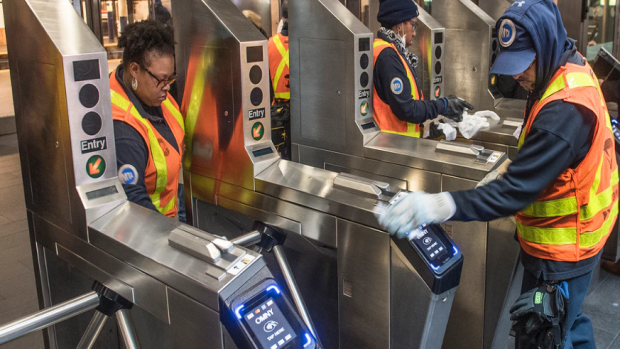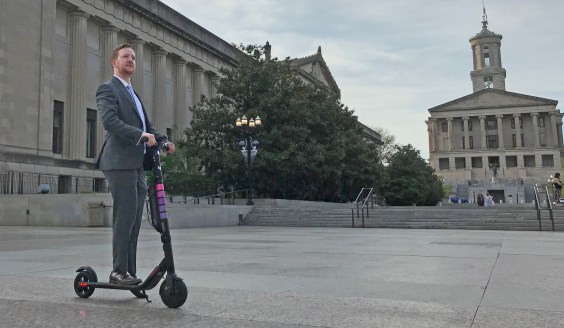
The coronavirus crisis has created whole new categories of heroes: grocery-store workers, postal and delivery workers, social services and, especially, the people who get them to work — our transit workers. Overnight, bus operators and train conductors have assumed a vital role on the front lines of a pandemic. Under normal circumstances, 2.8 million of our essential workers commute via transit. Some can shift to private vehicles or bikes, but transit is a lifeline for essential workers — and thus the country — in this moment of crisis.
Transit workers now face a grim daily calculus: report to work and risk another day of exposure, or stay home and risk losing their income, job, and, ironically, their health care. Agencies must preserve the health of their workforce by distributing personal protective equipment such as masks (especially N95 respirators) and gloves, regularly cleaning common workspaces and equipment, addressing overcrowded offices and break rooms, and rotating shifts can help keep workers safe. The most at-risk can be reassigned to roles with less exposure or even given automatic sick leave.
Take “Brenda,” a 70-year-old bus operator for a New England transit agency. She has underlying respiratory conditions, yet is still working amid the pandemic. Brenda (who asked that her real name not be used because she worries about retaliation) has as many as 50 riders on her bus at a time — far too many for social distancing. Her defenses against COVID-19? Gloves, Lysol, and asking riders to not linger near the front. She doesn’t have a mask; the agency doesn’t have enough. Despite the risk, she is classified as an essential worker, and so cannot use sick days without a doctor’s note. Her family fears it is only a matter of time before she falls ill.
For some transit workers, time has run out. As of April 12, New York’s MTA had announced at least 50 COVID-19 related deaths. By April 10, Boston’s MBTA was reporting that 53 workers tested positive for COVID-19, and at least one had died.In Snohomish County, Wash., COVID-19 has claimed a 41-year-old bus driver’s life. Transit agencies must act now to safeguard the health of their workers and maintain essential services. And their response to this crisis, unlike any other they have faced, must be guided by the fundamental logistical and public-health realities of a pandemic virus.
Critical transit service will deteriorate if its workforce falls ill. We have already seen entire lines close in San Jose and service cuts in New York. With less service, the remaining trains and buses risk becoming overcrowded, as the MTA saw when it recently rolled out its essential-service schedule. Such moves raise the risk to the remaining workers and can spiral into a vicious cycle.
Agencies also must adapt service schedules to meet the requirements of pandemic response adapting their schedules to help the functioning of other essential services and by reducing overcrowding on busy routes. In Massachusetts, morning commuter rail was restored to let health-care workers get to their shifts on time. In Memphis, bus routes to the hospital now run seven days a week. Other measures include transparent occupancy caps for drivers and riders to follow. Drivers can radio dispatch to send more service, and the system can adapt with new data.
Most important, agencies must partner with public-health experts in order to develop practices to keep operators and essential workers healthy. Otherwise, we risk drivers becoming not only victims but vectors for more illness. For some workers, the situation is improving. The MTA recently announced a distribution of 75,000 surgical masks. Many agencies have adopted rear-door boarding and buffer zones in buses.
ATU demands that our #transit agencies and private contractors protect employees and their families during this #COVID19 crisis. Join in our demands and sign an online petition @ https://t.co/E1KWz0ZSwk #1u #p2 #publictransit #TogetherWeFightTogetherWeWin pic.twitter.com/KpyP1aQaB0
— ATU, Transit Union (@ATUComm) April 13, 2020
https://platform.twitter.com/widgets.js
But more can be done. Transit unions are asking for public support in their petitions to our transit agencies and leaders. Transit agencies should stand with unions and advocates in calling for test kits and safety equipment so that agencies aren’t scavenging for equipment online. Long term, they should adopt new technologies on vehicles and in public spaces, such as thermometer guns to help screen for fevers, better air filters, contactless payment systems, and even UV lights and sanitation robots.
COVID-19 has exposed widespread failures in how we protect our essential workforce. Hospitals, grocery stores, and delivery services all depend on functioning transit. When the crisis ends, we will need systematic change, including a dramatic expansion of paid leave, health care, and fair wages, in order to protect frontline workers and, through them, all of society. For now, we must take steps to ensure transit workers can function safely.
Darwin Keung (@darwhims) is a policy and public-health analyst at Tri-State Transportation Campaign. Toph Allen (@toph) is an epidemiologist specializing in emerging infectious diseases and an advisory-board member of Tri-State Transportation Campaign (@Tri_State).






